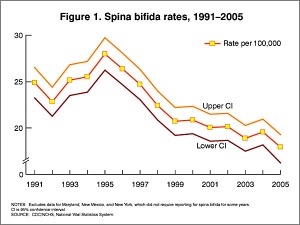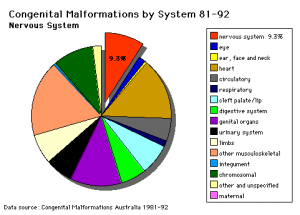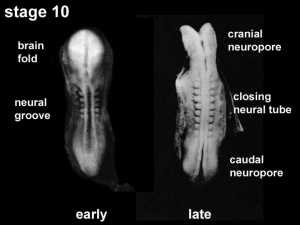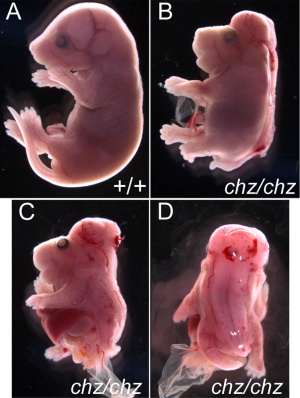Neural System - Abnormalities
Introduction
There are many different congenital and environmentally derived abnormalities associated with the nervous system. There are potentially 1000's of neurological abnormalities that could be listed on this page, therefore this current page is only a very brief introduction to some of these neural abnormalities. As the nervous system continues to develop postnatally, environmental issues such a nutrition (folate, iodine) and sensory abnormalities (hearing) can also impact on developmental milestones.
| Low Folic Acid and NTDs | International Classification of Diseases - Neural
Some Recent Findings
|
Neural Tube Closure
Dysraphism is the term often used to describe the defective fusion of the neural folds. The position and degree of failure of fusion will result in either embryonic death or a range of different neural defects. The way (mode) in which the human neural tube fuses has been a source of contention. In humans, fusion appears to initiate at multiple sites along the neural groove [4][5], this mode of closure may differ from that found in many animal species used in developmental studies.
Human Embryonic Death:
- 5 weeks with total failure of fusion.
- 6.5 weeks with opening over the rhombencephalon.
- survive beyond 7 weeks with a defect at the frontal and parietal regions.
Spina Bifida (Meningomyelocele)

|

|
| Meningomyelocele | Spina Bifida Rates (USA Data) |
There are potentially many different causes of spina bifida and neural tube defects. The basis of the abnormality is a failure of the neural tube to close caudally. At least one known cause is a low maternal diet of folic acid (folate) containing foods. (see Neural Tube Defects and Low Folic Acid or Folic Acid below)
Neural tube defects from failure to close can be screened by amniocentesis or ultrasound.
Alpha-fetoproetin normally present in the CSF, leaks and can be detected in amniotic fluid.
Cephalic Disorders
Cephalic (Greek, kephale = head) are a large group of abnormalities that relate to both skeletal (skull) and neural (brain) associated defects including: anencephaly, hydrocephalus, encephalocele, colpocephaly (occipital horn enlargement), lissencephaly (smooth brain), porencephaly (cyst or cavity in cerebral hemisphere), acephaly (absence of head), exencephaly (brain outside skull), macrocephaly (large head), micrencephaly (small brain), otocephaly (absence of lower jaw), brachycephaly (premature fusion of coronal suture), oxycephaly (premature fusion of coronal suture + other), plagiocephaly (premature unilateral fusion of coronal or lambdoid sutures), scaphocephaly (premature fusion of sagittal suture), trigonocephaly.
Anencephaly

This is a neural tube defect, the basis of the abnormality is a failure of the neural tube to close cranially. Also called exencephaly or craniorachischisis.
Hydrocephalus
Hydrocephalus (historic image from Hess, 1922)
This is a defect of cerebrospinal fliud (CSF) flow, excess fluid production or impaired fluid absorption and can be congenital or acquired. Estimated incidence of 1 in 1000 live births the condition leads to enlarged ventricles and head, separated skull cranial sutures and fontanelles. Obstruction of CSF flow can occur at any time (prenatally or postnatally) and leads to accumulation of within the ventricles. The time of onset will have different effects and should be compared to the equilivant neurological events that are occuring.
Ventricular obstruction usually occurs at the level of the cerebral aqueduct (narrowest site), but can occur elsewhere, and can be caused by viral infection or zoonotic disease.
Encephalocele
This defect is generally mesodermal in origin, leading to protrusion of brain and meninges outside the crainal cavity. The severity of the disorder can vary dependent upon the degree of mesodermal abnormality.
Encephalitis
Normally a postnatal clinical syndrome of the central nervous system resulting in inflammation of the brain parenchyma and caused by a range of pathogens (viral, bacterial and protozoal infections). This infectious disease is due mainly to viral pathogens: Herpes simplex encephalitis 10%–20% of cases, Murray Valley encephalitis virus, Japanese encephalitis virus, Australian bat lyssavirus, West Nile virus, Hendra virus and Nipah virus. The pathogen is generally included in the specific encephalitis naming; Varicella encephalitis and Toxoplasma meningoencephalitis.
- Links: Neural System - Abnormalities | TORCH Infections | PMC2700670)
Fragile X Syndrome
Fragile X Syndrome (FXS) is the most common form of inherited mental retardation and autism. The condition is caused by a loss of the functional fragile X mental retardation protein (FMRP) an RNA-binding protein that can regulate the translation of specific mRNAs. There are several suggested additional roles for this protein including synaptic development and function[7] and in adult neurogenesis.[8]
- Links: Fragile X Association of Australia |
Autism
Autism (autism spectrum disorder, ASD) is a behaviourally defined brain disorder in children. Features include: impoverished verbal and non-verbal communication skills, reduced social interactions (bias their attention towards objects rather than the surrounding social situation), behavioural impairments in attention engagement/disengagement, poor emotional discrimination and facial recognition, and fail to response to their own names. There exist many different and unproven claims as to the origins of autism.
Developmentally associated with neural maturation changes in cortical thickness and organization, and particularly affecting pyramidal neurons. A rat model shows structural and behavioural features of autism as a result of altering the trajectory of early postnatal cortical development.[9]
Newborn Neural Exam
Newborn Abnormal Links: behaviour | cranial nerves | Newborn Tone - resting posture | upper extremity | arm traction | arm recoil | scarf sign | hand position | lower extremity | leg traction | leg recoil | popliteal angle | heel to ear | neck tone | head lag | head control | Newborn Positions - prone | ventral suspension | vertical suspension | Newborn Reflexes - deep tendon reflexes | plantar reflex | suck, root | Moro | Galant | stepping | grasp | Newborn Head - head shape and sutures | head circumference
International Classification of Diseases
The International Classification of Diseases (ICD) World Health Organization's classification used worldwide as the standard diagnostic tool for epidemiology, health management and clinical purposes. This includes the analysis of the general health situation of population groups. It is used to monitor the incidence and prevalence of diseases and other health problems. Within this classification "congenital malformations, deformations and chromosomal abnormalities" are (Q00-Q99) but excludes "inborn errors of metabolism" (E70-E90).
Congenital malformations of the nervous system (Q00-Q07)
Q00 Anencephaly and similar malformations
- Q00.0 Anencephaly, Acephaly, Acrania, Amyelencephaly, Hemianencephaly, Hemicephaly
- Q00.1 Craniorachischisis
- Q00.2 Iniencephaly
Q01 Encephalocele
Incl.: encephalomyelocele, hydroencephalocele, hydromeningocele, cranial meningocele, cerebral meningoencephalocele
Excl.: Meckel-Gruber syndrome (Q61.9)
- Q01.0 Frontal encephalocele
- Q01.1 Nasofrontal encephalocele
- Q01.2 Occipital encephalocele
- Q01.8 Encephalocele of other sites
- Q01.9 Encephalocele, unspecified
Q02 Microcephaly
Incl.: Hydromicrocephaly Micrencephalon Excl.: Meckel-Gruber syndrome (Q61.9)
Q03 Congenital hydrocephalus
Incl.: hydrocephalus in newborn Excl.: Arnold-Chiari syndrome (Q07.0) hydrocephalus: acquired (G91.-) due to congenital toxoplasmosis (P37.1) with spina bifida (Q05.0-Q05.4)
- Q03.0 Malformations of aqueduct of Sylvius Aqueduct of Sylvius: anomaly obstruction, congenital stenosis
- Q03.1 Atresia of foramina of Magendie and Luschka Dandy-Walker syndrome
- Q03.8 Other congenital hydrocephalus
- Q03.9 Congenital hydrocephalus, unspecified
Q04 Other congenital malformations of brain
Excl.: cyclopia (Q87.0) macrocephaly (Q75.3)
- Q04.0 Congenital malformations of corpus callosum, Agenesis of corpus callosum
- Q04.1 Arhinencephaly
- Q04.2 Holoprosencephaly
- Q04.3 Other reduction deformities of brain, Absence, Agenesis, Aplasia, Hypoplasia of part of brain, Agyria, Hydranencephaly, Lissencephaly, Microgyria, Pachygyria Excl.: congenital malformations of corpus callosum (Q04.0)
- Q04.4 Septo-optic dysplasia
- Q04.5 Megalencephaly
- Q04.6 Congenital cerebral cysts, Porencephaly, Schizencephaly, Excl.: acquired porencephalic cyst (G93.0)
- Q04.8 Other specified congenital malformations of brain, Macrogyria
- Q04.9 Congenital malformation of brain, unspecified Congenital: anomaly, deformity, disease or lesion, multiple anomalies NOS of brain
Q05 Spina bifida
Incl.: hydromeningocele (spinal), meningocele (spinal), meningomyelocele, myelocele, myelomeningocele, rachischisis, spina bifida (aperta)(cystica), syringomyelocele Excl.: Arnold-Chiari syndrome (Q07.0), spina bifida occulta (Q76.0)
- Q05.0 Cervical spina bifida with hydrocephalus
- Q05.1 Thoracic spina bifida with hydrocephalus Spina bifida: dorsal thoracolumbar with hydrocephalus
- Q05.2 Lumbar spina bifida with hydrocephalus, Lumbosacral spina bifida with hydrocephalus
- Q05.3 Sacral spina bifida with hydrocephalus
- Q05.4 Unspecified spina bifida with hydrocephalus
- Q05.5 Cervical spina bifida without hydrocephalus
- Q05.6 Thoracic spina bifida without hydrocephalus Spina bifida: dorsal NOS, thoracolumbar NOS
- Q05.7 Lumbar spina bifida without hydrocephalus, Lumbosacral spina bifida NOS
- Q05.8 Sacral spina bifida without hydrocephalus
- Q05.9 Spina bifida, unspecified
Q06 Other congenital malformations of spinal cord
- Q06.0 Amyelia
- Q06.1 Hypoplasia and dysplasia of spinal cord, Atelomyelia, Myelatelia, Myelodysplasia of spinal cord
- Q06.2 Diastematomyelia
- Q06.3 Other congenital cauda equina malformations
- Q06.4 Hydromyelia Hydrorachis
- Q06.8 Other specified congenital malformations of spinal cord
- Q06.9 Congenital malformation of spinal cord, unspecified Congenital: anomaly, deformity, disease or lesion, NOS of spinal cord or meninges
Q07 Other congenital malformations of nervous system
Excl.: familial dysautonomia [Riley-Day] (G90.1), neurofibromatosis (nonmalignant) (Q85.0)
- Q07.0 Arnold-Chiari syndrome
- Q07.8 Other specified congenital malformations of nervous system Agenesis of nerve, Displacement of brachial plexus, Jaw-winking syndrome, Marcus Gunn's syndrome
- Q07.9 Congenital malformation of nervous system, unspecified Congenital: anomaly, deformity, disease or lesion, NOS of nervous system
References
- ↑ <pubmed>22171071</pubmed>
- ↑ <pubmed>21306277</pubmed>
- ↑ Abeywardana S & Sullivan EA 2008. Neural tube defects in Australia. An epidemiological report. Cat. no. PER 45. Sydney: AIHW National Perinatal Statistics Unit | PDF.
- ↑ <pubmed>8267004</pubmed>
- ↑ <pubmed>10909899</pubmed>
- ↑ Mathews TJ. Trends in spina bifida and anencephalus in the United States, 1991-2005, National Vital Statistics System.
- ↑ <pubmed>18957214</pubmed>
- ↑ <pubmed>20386739</pubmed>
- ↑ Chomiak T, Karnik V, Block E, Hu B. Altering the trajectory of early postnatal cortical development can lead to structural and behavioural features of autism. BMC Neurosci. 2010 Aug 19;11:102. PMID: 20723245| BMC Neurosci.
Search PubMed
Search Bookshelf: neural development abnormalities
Search Pubmed: neural development abnormalities
Glossary Links
- Glossary: A | B | C | D | E | F | G | H | I | J | K | L | M | N | O | P | Q | R | S | T | U | V | W | X | Y | Z | Numbers | Symbols | Term Link
Cite this page: Hill, M.A. (2024, April 27) Embryology Neural System - Abnormalities. Retrieved from https://embryology.med.unsw.edu.au/embryology/index.php/Neural_System_-_Abnormalities
- © Dr Mark Hill 2024, UNSW Embryology ISBN: 978 0 7334 2609 4 - UNSW CRICOS Provider Code No. 00098G


